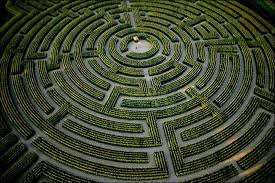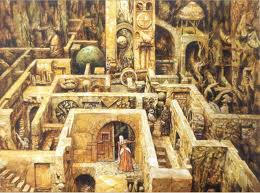Part of my annual December tradition is to seek out a few days’ solitude at a nearby retreat center tucked deep in the redwoods (the Ben Lomond Quaker Center – love it). Not only does it give me a breather from the too-loud, too-bright, too-frenzied aspect of the month, it allows me to observe this otherwise sacred season in its most organic state. Here, it’s impossible not to note the darkness that descends so early, the bare deciduous trees with their leaves lying fallow, the invisible bulbs and seedlings sleeping beneath the damp, chilly ground cover. There is a stillness in the air, yet a sense of expectancy. I catch up on sleep, meditate, take walks through the center’s eighteen acres of forest. One redwood grove I pass has an open center and is framed on three sides by tiers of redwoods rising up like amphitheater seating. Standing in the center (lying on the ground is even better), looking up at the circle of trees above me, is one of the year’s peak spiritual experiences.
Spiritual, too, is the center’s nearby labyrinth, an enormous circular maze of sorts, outlined by smooth, flat grey stones. From the distance, it looks modest, unassuming. The goal of a labyrinth experience is equally unassuming: you walk in, pause at the center, you walk out.
Labyrinths have been around for 4000 years, used as a place for contemplation, prayer, ritual, spiritual guidance. They’ve been made out of stone, shrubbery, sand, earth or even edible substances like cornmeal or flour. You can walk one merely to admire its geometric precision. You can pose yourself a question at the onset and meditate over it as you walk, in the hope of receiving some sort of insight once you’re in the center. Or you can clear your mind of all thoughts or goals and simply receive what the experience brings you.
I love walking labyrinths. I take one or two steps and boom, I’m in the middle of it, rows on either sides comforting me, assuring me that I’m on the right path. I’m always reminded right at that moment of the way it feels to start a new big project, be it writing a novel, deciding to play the violin, taking on an ambitious piece of music. You’re excited, daunted by what lies in store, but the path gives you reassurance that all you need to do is put one foot in front of the next. And keep doing that.
But the labyrinth journey, like life, can be visually deceptive. What you thought was the middle was merely the beginning. And when you feel like you should be in the middle, ever closer to that sweet center, suddenly you are cast out to the very outer rung. It feels like you’ve made a mistake, and that you are now moving in wrong direction. You were so close to the finish line, the center, after all. You could see it there, two rows over.
But you keep walking. One step forward and another. Another. Patience returns. It’s about the journey, after all, and it is soothing when you give into its rhythm. And finally you arrive in the center. You see those rows of concentric rings all around you, and it looks so beautiful, so perfectly arranged, that you feel a little sheepish for ever having doubted your mission.
I hope I’ll always remember the insight I’ve gained in the labyrinth. Now, when I feel defeated at an unexpected detour or failure, when I’d been so sure I was approaching the finish line, I can remind myself that nothing is “wrong.” I didn’t fail. Instead, this less comfortable place is precisely where I was meant to be, as part of the journey. Being close enough to touch a goal is not the same as arriving there. And feeling woefully far from it does not mean it will take all that much longer to finally arrive. The arrival is timed right when it was intended to be.
It’s a nice gift to receive, this insight, and a nice month to receive it in.
This first appeared at Violinist.com in December 2010

